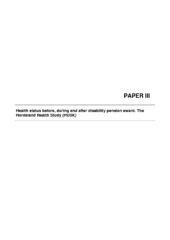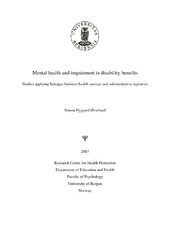| dc.description.abstract | Objective: An increasing number of people in Norway and most other western countries leave the workforce earlier than retirement age and depend on disability benefits for income security. There is no consensus concerning which factors may serve as an immediate explanation for this trend. The scientific community can at present not provide research based information on the general causes and consequences of disability benefits. This leaves those who must make decisions in this field short of evidence to inform their choices. The aim of the present thesis is to expand the empirically based knowledge on factors relevant as causes and consequences of disability benefits by combining data from public health surveys and registry information on disability benefit awards. The thesis is based on three papers that all focus on mental health and impairment in relation to disability benefits. First, we examined differences in impairment between employed, unemployed and disability benefit recipients. Impairment has, in the context of disability benefits, previously been seen as an obvious consequence of disease. We aimed at empirically examining aspects of that presumption. Second, previous studies have found that both depression and insomnia are underestimated as risk factors for disability pension award. As these frequently co-occur, we aimed at comparing their relative impact on disability pension award. Third, there is very little knowledge on health across stages before, during and after disability pension award, and variation in both positive and negative directions are plausible. We wanted to compare health status in disability pensioners across these stages from seven years before disability pension award to seven years after the award. Method: All three studies employ data material that is a combination of population based health surveys and data on disability benefits from official registries. Papers I and III are based on population data from the Hordaland Health Survey (HUSK) in 1997-99. The 18 581 born in the years 1953-57 (aged 40-47 at participation) who participated (63 %) answered questionnaires on physical conditions, mental health, somatic symptoms, and perceived health, as well as socio-economic status. Paper II is based on the second wave of the population based Nord-Trøndelag Health Study (HUNT 2) 1995-97. Of those invited, 37 308 eligible participants within working age answered questions on insomnia and depression as well as covariates including somatic illness, health behaviour and socio-economic status. These health surveys were linked to comprehensive registries on disability benefits using the national person identification number. The merged datasets comprising information on health and benefit receipt were used to study the aims through three different designs. In paper I we used a cross-sectional design. We compared the extent of self-reported impairment (measured with SF-12) between participants who were disability benefit recipients and those employed. Further, employing linear regression models, we examined to what extent the group difference in impairment could be explained by mental health, somatic symptoms, and physical conditions. In paper II we compared the risk of disability pension award across four groups defined by case-level depression and insomnia, employing a historical cohort design with an 18-48 month follow-up period. Logistic regression models were employed and results were also presented as population attributable fractions (PAFs). In paper III, we aimed at examining if health status differs between strata of individuals defined by time between the health survey and disability pension award. Groups were defined as 3-7, 1-3, and 0-1 years before the award, and 0-1, 1-3, and 3-7 years after. Measures of impairment, somatic symptoms, physical conditions, and mental health were compared between these groups. Results: In the first study we found that disability benefit recipients reported more impairment than employees. While most of the difference in mental impairment (SF-12, perceived mental health) was explained from anxiety and depression, about half of the difference in physical impairment (SF-12 perceived physical health) remained unexplained after adjustment for all physical conditions, mental health and symptoms. In the second study, insomnia was found to be an equally strong predictor of disability pension award as depression. Both the effects of depression and insomnia were confounded by socio-economic factors and other health problems, but the relative difference between insomnia and depression remained through all steps of adjustments in the employed regression models. Due to differences in prevalences, the population attributable fractions of insomnia exceeded that of depression. Significant effect moderation was found for age; both depression and insomnia were stronger risk factors for disability pension award in younger strata (<45 years) than older. In the third study, disability pensioners reported more somatic illness, somatic and mental symptoms, and impairment than the remaining sample (participants who were not awarded a disability pension during the observation period). This difference was observed in all groups in the observation period ranging from seven years before to seven years after the disability pension award. Measures on physical conditions were stable across the strata defined by time between health survey participation and disability pension award, though the groups measured after time of the award, reported more prescribed medication. However, we Conclusions: The results over these three studies support previous notions that mental health is important and might be underestimated in relation to disability benefits. Impairment, as measured by perceived health, might not only be a result of somatic and mental health problems, but may also be an independent factor leading up to disability pension award. Individuals’ perceptions of own health and impairment might take into account many factors that are not caused by medical conditions. The results suggest that an increased focus on health perceptions might be needed in studies on disability benefits. I Norway, disability pension is officially not awarded for insomnia. Yet does insomnia predict disability pension award just as strong as depression, which is the most common diagnoses in disability pension award. Clinically, insomnia is often regarded as reactive to any other present condition. As insomnia often is left untreated, improved treatment can perhaps serve to reduce work disability following from insomnia. Finally, the design in paper III precludes any firm conclusions as to what causes the observed group differences. Candidate explanations include temporary health deteriorating effects from the disability pensioning process, beneficial effects of being removed from harmful work conditions and spontaneous recovery after increasing health problems leading up to disability pension award. If the results in part are caused by features of the disability pension process itself, the results are relevant for rehabilitation and treatments of patients where a disability benefit is a topic. Recent policy changes have introduced temporary benefits with regular re-evaluations of health and impairment. Such repeated pension assessments, may have unintended adverse effects. | en_US |
| dc.relation.haspart | Paper I: BMC Public Health 6, Øverland, Simon; Glozier, Nicholas; Mæland, John Gunnar; Aarø, Leif Edvard; Mykletun, Arnstein, Employment Status and Perceived Health in the Hordaland Health Study (HUSK), p. 219. © 2006 Overland et al; licensee BioMed Central Ltd. <a href="http://dx.doi.org/10.1186/1471-2458-6-219">http://dx.doi.org/10.1186/1471-2458-6-219</a> | eng |
| dc.relation.haspart | Paper II: Øverland, Simon; Glozier, Nicholas ; Sivertsen, Børge; Stewart, Robert; Neckelmann, Dag; Krokstad, Steinar; Mykletun, Arnstein, A comparison of insomnia and depression as predictors of disability pension. The HUNT Study. (Resubmitted after review). Permission has been granted by the Associated Professional Sleep Societies, Westchester, IL, USA in October 2008 to The University of Bergen Library for online use of the article: Overland S; Glozier N; Sivertsen B; Stewart R; Neckelmann D; Krokstad S; Mykletun A. A comparison of insomnia and depression as predictors of disability pension: The HUNT Study. SLEEP 2008;31(6):875-880. Copyright 2008 Associated Professional Sleep Societies. | eng |
| dc.relation.haspart | Paper III: Øverland, Simon; Glozier, Nicholas; Henderson, Max; Mæland, John Gunnar; Hotopf, Matthew; Mykletun, Arnstein, Health status before, during and after disability pension award. The Hordaland Health Study (HUSK). (Submitted) | eng |




